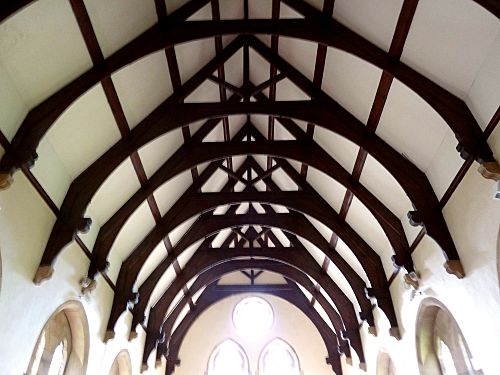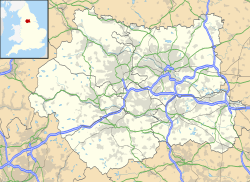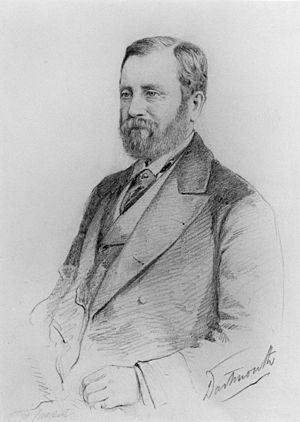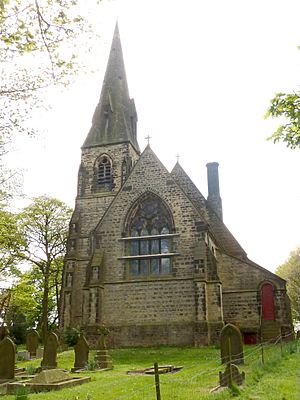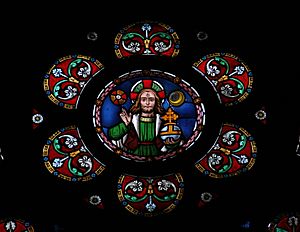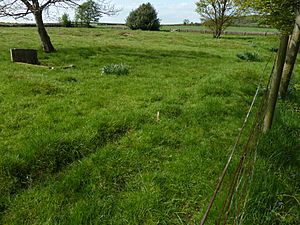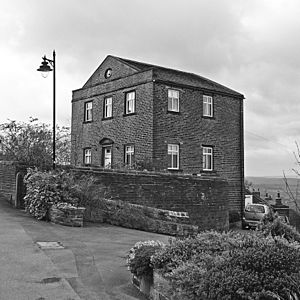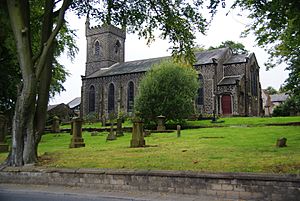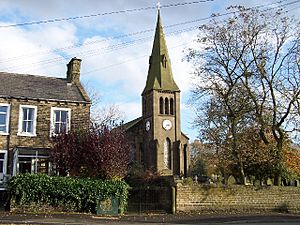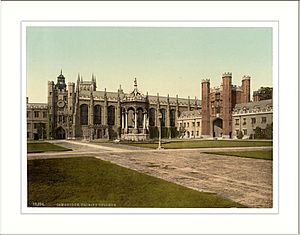Church of St Thomas, Thurstonland facts for kids
Quick facts for kids Church of St Thomas, Thurstonland |
|
|---|---|
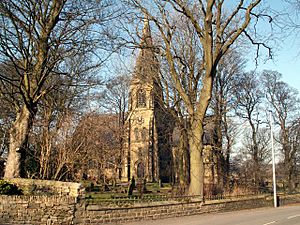
St Thomas in 2008
|
|
| 53°35′35″N 1°45′02″W / 53.59316°N 1.75056°W | |
| OS grid reference | SE 166108 |
| Location | Marsh Hall Lane, Thurstonland, West Yorkshire, HD4 6XD |
| Country | England |
| Denomination | Anglican |
| History | |
| Consecrated | 3 October 1870 |
| Architecture | |
| Heritage designation | Grade II listed, #1135375 |
| Architect(s) | Mallinson and Barber |
| Architectural type | Parish church |
| Style | Gothic Revival, Arts and Crafts |
| Groundbreaking | 1869 |
| Completed | 1870 |
| Construction cost | £3,000 |
| Specifications | |
| Capacity | designed for 385 |
| Administration | |
| Parish | St Thomas Thurstonland |
| Deanery | Kirkburton 40107 |
| Archdeaconry | Halifax 401 |
| Diocese | Anglican Diocese of Leeds |
The Church of St Thomas in Thurstonland, West Yorkshire, England, is an Anglican church. It's a beautiful building designed in the Gothic Revival style, with touches of the Arts and Crafts style. Architects James Mallinson and William Swinden Barber completed it in 1870.
The church was built thanks to funding from William Legge, 5th Earl of Dartmouth. Robert Bickersteth, who was the Bishop of Ripon, officially opened it. The church's tower and spire reach 109 feet (33 meters) high. Inside, the main hall (nave) has a special arch-braced hammerbeam roof.
The first vicar to lead services in this church was Rev. Robert Boyle Thompson. He was a dedicated missionary who had done important work helping people in the poor areas of Seven Dials, London. He became the vicar of Thurstonland when he was 28 years old.
Contents
- Building the Church of St Thomas
- Church Design and Features
- Churchyard and History
- Past Vicars of St Thomas' Church
- George Lloyd (1861–1865)
- Robert Boyle Thompson (1868–1877)
- David Harrison (1877–1882)
- John Leech (1882–1906)
- Arnold Escombe Jerram (1906–1910)
- Philip Sydney Brown (1910–1923)
- Maurice Gerber (1923–1939)
- Arthur Dilworth (1939–1943)
- Norman Gearey Hounsfield (1943–1949)
- Ernest Parry (1950–1953)
- Philip Frederick Wainwright Frost (1953–1969)
- Edward Harold Forshaw (1969–1973)
- Raymond Laycock Wainwright (1974–1989)
- John Sean Robertshaw (from 1996)
- Church Activities and Community
Building the Church of St Thomas
The church was designed between 1867 and 1870 by Mallinson & Barber. However, it was William Swinden Barber who closely watched over the building work. This means he was mostly in charge of the plans. Old drawings from 1867 and sketches are kept at the West Yorkshire Archive Service. It's thought that another church, St John the Evangelist in Birkby, built in 1853, might have given them some ideas for the design.
Many skilled workers helped build the church. Leonard North from Kirkburton was the clerk of works in 1869, followed by Thomas Elliott from Bradford in 1870. George Pollard from Huddersfield was the stone worker. Joah Swallow from Hepworth was the joiner, and Lockwood from Honley was the plumber. Goodwin & Sons from Huddersfield put on the slate roof. Alfred Jessop from Shepley did the plastering, and Brighouse from Huddersfield was the painter. Thornton from Huddersfield installed the heating system.
How the Church Got Started
By 1869, three new churches had already been built in the Kirkburton area. This was thanks to the efforts of the vicar, Rev. Richard Collins. But in Thurstonland, there was only a small, old chapel room. This room was originally built in 1810 and used as a simple chapel for Kirkburton from 1834 to 1870. Around 1850, people tried to raise money for a new church, but it didn't work. A second attempt in 1867–1868 was successful.
Thurstonland was a village with people who worked in farming and factories. They didn't have much money, so they couldn't pay for a new church themselves. The Church of England asked its wealthier members for help. Mr. J.F. Winterbottom gave the land for the church. The building itself was paid for by William Legge, the Earl of Dartmouth, and others. Ladies in the community even organized a bazaar to raise money. Local people raised £100 and offered to help by hand-levelling the ground. At the church's opening, it was mentioned that money was also being raised for a new house for the vicar.
Laying the Foundation Stone
The foundation stone was placed on Monday, July 26, 1869, at 1:30 PM. A large crowd gathered to watch. Countess Augusta of Dartmouth and Rev. Richard Collins led a procession. They were followed by the Earl of Dartmouth and Rev. R.B. Thompson, who would be the first vicar of the new church. More than 20 other church leaders and important guests also joined. The architect, W.S. Barber, was there too. The choir, a band, Sunday School children, and other spectators stood outside the ropes.
The crowd sang a hymn. The Earl of Dartmouth was given a special silver trowel to spread the mortar for the stone. Inside the foundation stone, there was a bottle with important papers about the ceremony. A brass plate was placed over the hole, saying that the church was dedicated to St Thomas. It also listed the names of those involved, including the Earl, the vicars, the churchwarden, and the architects.
The stone was carefully lowered into place. The Countess tapped it with a mallet, and it was declared officially laid. Rev. Thompson ended the service, and the choir sang God Save the Queen. The Earl then gave a speech, thanking everyone and talking about the importance of donations.
Afterward, three hundred people enjoyed lunch in a large tent nearby. There were many more speeches, including a long one from the Earl. The architect, Barber, also spoke.
Church Opening Ceremony
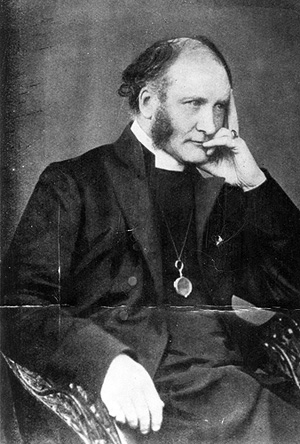
The church and its graveyard were officially opened on October 3, 1870, at 11 AM. This ceremony was led by Robert Bickersteth, the Bishop of Ripon. Even though the spire wasn't fully finished, the church was ready. The pews were completely full as the bishop and over thirty local church leaders walked into the church, saying Psalm 24. The bishop read the special prayer for the opening. The choir sang, and the organ, which was almost finished, was played for the first time.
The bishop gave a sermon based on Psalm 122, verse 1. He talked about the new building and the need for people to support the church with their spirit and money. He also mentioned that they still needed £400 to pay off the building costs. The collection that day raised £363 7s 1d. After the service, the bishop and clergy went outside to officially open the burial ground.
Another lunch was held in a tent for about 100 people, including the Bishop, the Earl and Countess of Dartmouth, and other important guests. The Vicar of Kirkburton mentioned that the architect, W.S. Barber, couldn't be there because he was ill. He praised Barber for working very hard on the church. Rev. Thompson spoke about how the new church had free seating, meaning rich and poor could worship together. The evening service raised another £50, bringing the total collection for the day to £363 7s 1d.
Church Information
You can find historical leaflets about the church at the building itself. Records for St Thomas' church, including old church magazines, are kept at the West Yorkshire Archive Services.
Church Design and Features
The Church of St Thomas is a Grade II listed building. This means it's an important historical building. It's located on Marsh Hall Lane in Thurstonland, Huddersfield, West Yorkshire. The area around it is also protected as a Conservation Area.
Original Look
When it was first designed, the church was meant to hold 385 adults and children. The main hall (nave) was 69 feet (21 meters) long and 28 feet (8.5 meters) wide, with a roof ridge 47 feet (14 meters) high. The tower was 17.5 feet (5.3 meters) square and 57 feet (17 meters) tall. The stone spire was planned to be 40 feet (12 meters) but ended up being 52 feet (16 meters) high.
The ground floor of the tower was used as the church entrance. The first floor of the tower had a gallery for children, right under the single bronze bell. The nave roof had exposed timber beams. The pews and choir stalls were made of stained wood and designed by Mallinson and Barber. These seats were free for everyone, not rented out. The oak pulpit stood on a stone base, and the carved stone font was near the south-west door.
Outside the Church
The church is built from rough-cut stone with smooth stone details. The slate roof has a stone gutter. The tower is at the east end of the main hall. It has a small stair tower and a stone spire with four small windows called lucarnes. Above the south door, there's a special carved area with a figure underneath.
Inside the Church
Tower Interior
The tower has four levels. The ground floor is the church's entrance. The first floor is the children's gallery, which has stepped seating and large windows. This gallery used to be open to the main hall, like a balcony. Around 1984, a screen and door were added to close it off. Children could use a separate staircase to get to the gallery without disturbing the service. This gallery is no longer used, and the steps are not safe.
The second floor holds the clock mechanism, made in 1889 by Potts of Leeds. This company still maintains it today. This room has no windows and is dark. The third floor is the bell chamber, where the single bronze bell and its clapper are located.
Above the bell, you can see inside the spire. It's a hollow cone made of stone blocks, with no inner support. It's bright inside because of the four small windows at the bottom and eight larger openings higher up.
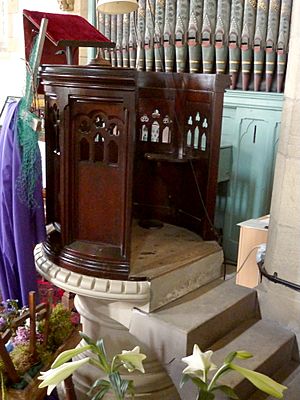
The main hall (nave) has an arch-braced hammerbeam roof. The dark wood of the roof stands out against the very light ceiling paint. Lots of light comes in through the clear windows. Until at least 1984, there was a carved marble font from 1870, designed by Mallinson and Barber. This font was replaced in the 1980s when a church room was built at the back of the nave. The original font's location is now unknown.
The entrance and aisle floors are covered with colorful tiles designed by Mallinson and Barber. The floor under the pews still has its original wooden boards. The organ was made in 1870 and fully restored in 1990. It fits perfectly into the arch designed for it. The original carved oak pulpit from 1870 is still in its place. Many of the original pews are still there, but some at the back were removed when the church room was added.
Chancel Interior
The east window, made by William Wailes, shows the story of the Parable of the Good Samaritan. It cost £100 and was paid for in 1870 by local people to remember Thomas Brooke. The reredos (a decorated screen behind the altar) was added in the 1920s. The sanctuary floor has decorative tiles arranged in a pattern designed by Mallinson and Barber. These tiles were paid for by D. Sharman, who was the head of Thurstonland Endowed School. The choir stalls and the altar rail are beautifully carved and were designed by Mallinson and Barber.
Inside Views
-
East window by William Wailes
Churchyard and History
Even though the church was officially opened in 1870, part of the churchyard was used for burials by March 5, 1862. The churchyard is an Anglican burial ground, but it also has records of nonconformist and Catholic burials. The churchyard contains Commonwealth war graves for five British Army soldiers and one Royal Air Force airman from World War I.
Storthes Hall Section
The churchyard has about 2,000 graves of patients who died at Storthes Hall Hospital (1904–1991) in Kirkburton. Most of these graves are unmarked and are in a separate field behind the church. This section was added by Rev. Arnold Escombe Jerram before he left in 1910.
Around 1913, some villagers worried that the burials of people without families were causing health problems. This was because the person in charge of burials was leaving graves open to the weather and not filling them until they had four coffins inside. The authorities said that the hospital's use of the graveyard helped Thurstonland by paying taxes. They also said that only about fifty people a year, who had no relatives to claim them, were buried there. Rev. P.S. Brown, who was the vicar of Thurstonland and chaplain to Storthes Hall at the time, said the burials were not a danger to health.
Past Vicars of St Thomas' Church
George Lloyd (1861–1865)
Reverend George Lloyd was in charge of Thurstonland from 1861 to 1865. He used the old chapel room before the current church was built. He was a very direct person and a key founder of the Huddersfield Archaeological and Topographical Association. This group later became the Yorkshire Archaeological Society. They helped fund and organize digs at Slack Roman fort. The Earl of Dartmouth, who later helped fund St Thomas' Church, also supported Lloyd's archaeological work.
Robert Boyle Thompson (1868–1877)
Robert Boyle Thompson was from Ireland. He married Hannah Thewlis in 1867. He studied at Queen's College, Birmingham and became a deacon in 1865 and a priest in 1867. From 1865 to 1868, he was a curate in Longwood, West Yorkshire. In 1868, he became the curate of the chapel in Thurstonland, expecting to lead the new St Thomas' Church when it was finished.
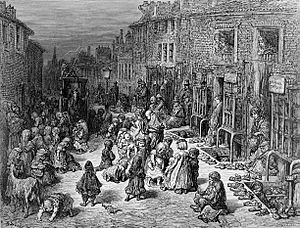
Thompson was the first vicar to use the new church building. He officially became the vicar of St Thomas' in May 1871 and stayed until 1877. Later, he worked in other churches, including St James-the-Less, Bethnal Green in London. He was known for his "great work" helping people in the poor areas of Seven Dials, London. He was also a missionary for the London Diocese. From 1882 to 1894, he was the vicar of St Lawrence and St Paul's Church in Pudsey. He passed away on August 10, 1906.
David Harrison (1877–1882)
David Harrison was born in Colne, Lancashire. He married Matilda and had a son named Hartley. He became a deacon in 1873 and a priest in 1875. From 1873 to 1877, he was a curate at Christ Church, Linthwaite. People there really liked him because of his sermons and his kind nature.
In August 1877, he became the vicar of St Thomas'. He died in June 1882 at the age of 37. His funeral started at St Thomas' Church, with many church leaders and parishioners attending. A large number of people also traveled by train to Colne to see him buried at Christ Church, Colne.
John Leech (1882–1906)
John Leech was born in Cumberland. He married Emma Maude Preston in 1882. They had two sons and two daughters, all born in Thurstonland. One of their daughters later married another vicar of Thurstonland, M. Gerber.
Leech studied at London College of Divinity and Durham University. He became a deacon in 1880 and a priest in 1881. He was a curate in Kirkburton from 1880 to 1882. On July 25, 1882, he became the vicar of Thurstonland and stayed until 1906. He was involved in many church activities, including preaching sermons and leading debates. In July 1906, he became the vicar of the Church of St John the Evangelist in Golcar, Huddersfield, where he served for 25 years until 1931. He passed away in 1932.
Arnold Escombe Jerram (1906–1910)
Arnold Escombe Jerram was born in Clapham, Surrey. He married Anna Christina Ravenhill in 1895. They had seven children. Sadly, one of his sons was killed in action during World War II in 1914.
He studied at Trinity College, Cambridge and Leeds Clergy School. He became a deacon in 1892 and a priest in 1893. He served as a curate in different places before becoming the vicar of Thurstonland in July 1906. He stayed until 1910. While in Thurstonland, he was active in the local council and other community groups. Later, he became a chaplain at St Oswald's Hospital in Worcester and an Honorary Canon of Worcester Cathedral. He died in 1934.
Philip Sydney Brown (1910–1923)
Philip Sydney Brown was born in Aston, Birmingham. He married Beatrice Emily Lowrance in 1898 and had one daughter. He studied at Queen's College, Birmingham. He became a deacon in 1888 and a priest in 1889. He served as a curate in Dewsbury Moor and then as a vicar in Wrenthorpe, Wakefield.
From 1910 to 1923, he was the vicar of Thurstonland. During this time, he also served as a chaplain at Storthes Hall Hospital. He was also a member of the Thurstonland and Farnley Tyas Urban Council. After Thurstonland, he became the vicar of Birchencliffe, Huddersfield, until he retired in 1935. He passed away in 1938.
Maurice Gerber (1923–1939)
Maurice Gerber's exact birth details are unclear, but he married Clara Winifred Maude Leech in 1927. Clara was the daughter of John Leech, a previous vicar of Thurstonland.
Gerber studied at Durham University and the London College of Divinity. He became a deacon in 1911 and a priest in 1912. He served as a curate in several places before becoming the vicar of Thurstonland in December 1923. He stayed for 16 years, until 1939. During his time, he was also the chaplain at Storthes Hall psychiatric hospital. Later, he was the vicar of Thurgoland, Sheffield. He passed away in 1967 in Wales.
Arthur Dilworth (1939–1943)
Arthur Dilworth was a scholar at Worcester College, Oxford. He became a deacon in 1924 and a priest in 1925. He worked as a missionary in Burma (now Myanmar) from 1927 to 1939. He was the principal of a divinity school and a superintendent for a mission there.
In 1939, he returned to England and became the vicar of Thurstonland and chaplain of Storthes Hall. He stayed until 1943. After Thurstonland, he served in several other churches across England. He passed away in 1989 in Scarborough.
Norman Gearey Hounsfield (1943–1949)
Norman Gearey Hounsfield was born in Rotherham. He married Edith Margaret Denholm in 1913. Their son, Lieutenant Kenneth Denholm Hounsfield, was killed in action in September 1944 during World War II.
He studied at Durham University and became a deacon in 1912 and a priest in 1913. He served as a curate in several places before becoming the rector of High Hoyland with Clayton West from 1927 to 1943. He was also an assistant rural dean of Huddersfield. He became the vicar of Thurstonland in 1943 and stayed until 1949. He passed away in 1955 in Durham.
Ernest Parry (1950–1953)
Ernest Parry studied at St Aidan's College and the University of Leeds. He became a deacon in 1914 and a priest in 1915. He served as a curate in Leeds.
In 1921, he went to Malaysia to work with Chinese people in Kudat, Borneo. He built a divinity school there called Holy Way, which opened in 1923. He taught and prepared people for church leadership while also learning local languages. He was the principal of this school until 1928 and the rector of Kudat until 1930. He returned to the UK for health reasons.
Back in the UK, he served in several churches, including Bramley, Leeds, and Halifax, West Yorkshire. He became the vicar of Thurstonland in 1950 and stayed until he passed away on August 26, 1953. He also wrote several books, including How to Read the New Testament and Sermon Psychology.
Philip Frederick Wainwright Frost (1953–1969)
Philip Frederick Wainwright Frost was born in Leeds. He married Ida M. Latimer in 1951. He studied at Keble College, Oxford and Queen's College, Birmingham. He became a deacon in 1948 and a priest in 1949.
He served as a curate in Ilkeston and Holmfirth. In 1953, he became the vicar of New Mill, West Yorkshire and also of Thurstonland. He lived at New Mill Vicarage and stayed in both roles until 1969. After that, he served in churches in Cumbria and then Allithwaite. He retired in 1985 and passed away in 1993.
Edward Harold Forshaw (1969–1973)
Edward Harold Forshaw was born in Birkenhead. He married Doris Lowe in 1945. He became a deacon in 1956 and a priest in 1957. He served as a curate in Redditch and Netherton, West Midlands.
From 1963 to 1969, he was the vicar of Stanley, West Yorkshire. He then became the vicar of New Mill, which included Thurstonland, from 1969 to 1973. He passed away in 1980.
Raymond Laycock Wainwright (1974–1989)
Raymond Laycock Wainwright was born in Wakefield. He joined the Community of the Resurrection in Mirfield in 1955. He became a deacon in 1956 and a priest in 1957. He served as a curate in Bingley and Almondbury.
He became the vicar of St Mary's in Gawthorpe and Chickenley Heath from 1960 to 1974. Then, he became the joint vicar of Christ Church, New Mill, and Thurstonland from 1974 to 1989. He retired in 1991 and passed away on April 25, 2008.
John Sean Robertshaw (from 1996)
Rev. Canon John Sean Robertshaw was born in Huddersfield in 1966. He studied at Cranmer Hall, St John's College, Durham. He became a deacon in 1993 and a priest in 1994.
He served as a curate in Morley from 1993 to 1996. He then became a team vicar for Upper Holme Valley, which includes Thurstonland, from 1996 to 2001. In 1998, he was appointed a chaplain for the Territorial Army. He became the team rector for Upper Holme Valley from 2001 to 2013. He was made an Honorary Canon of Wakefield Cathedral on September 8, 2011. He also earned a postgraduate degree in theology and ministry in 2012.
Church Activities and Community
St Thomas' Church serves the communities of Thurstonland and Stocksmoor. It works closely with local groups, including Thurstonland Endowed (VC) First School, village associations, and the local pub and cricket club.
The church holds regular services like all-age worship, holy communion, and family communion. There's also a regular sung eucharist and a children's church service twice a month. People from the community help with church services, like arranging flowers and providing refreshments. They also help with local events such as music concerts and the Harvest Festival, which take place at the church and in the Church Room. The church publishes a magazine called Parish News, which lists services and events.
The church is involved in charity work and organizes occasional family Sunday Fundays. It hosts groups like Rainbows, Mothers' Union, a knitting group, a weekly coffee morning, and a Sunday school. The church building has wheelchair access, toilets, and disabled parking.
